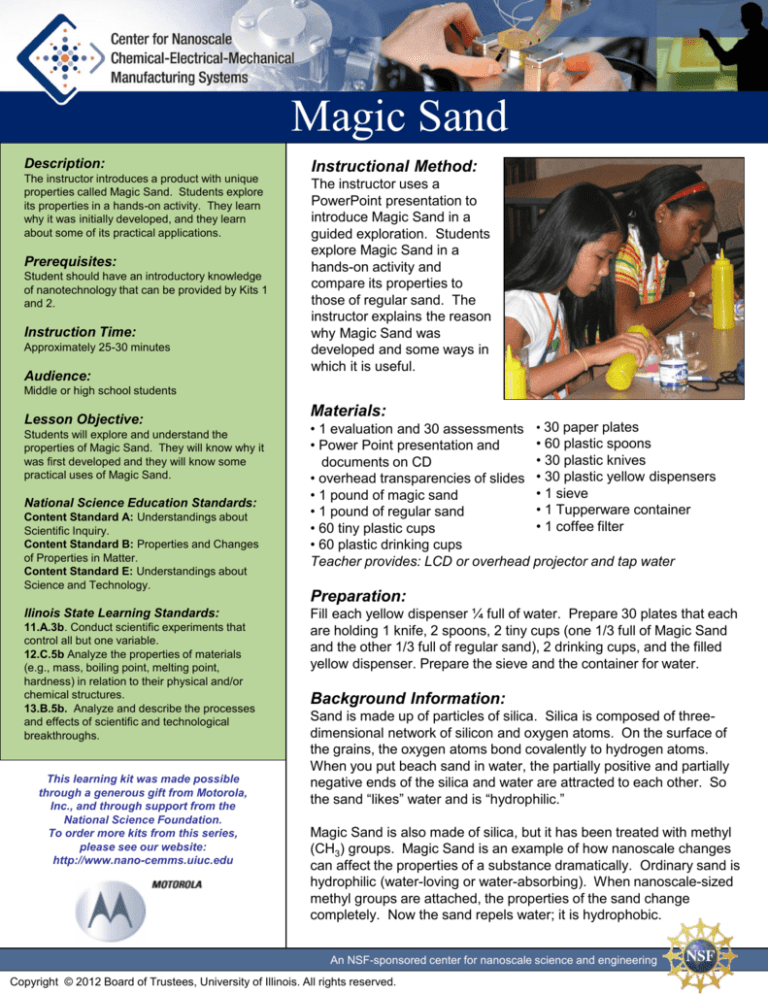
Magic Sand
Description:
The instructor introduces a product with unique
properties called Magic Sand. Students explore
its properties in a hands-on activity. They learn
why it was initially developed, and they learn
about some of its practical applications.
Prerequisites:
Student should have an introductory knowledge
of nanotechnology that can be provided by Kits 1
and 2.
Instruction Time:
Approximately 25-30 minutes
Audience:
Instructional Method:
The instructor uses a
PowerPoint presentation to
introduce Magic Sand in a
guided exploration. Students
explore Magic Sand in a
hands-on activity and
compare its properties to
those of regular sand. The
instructor explains the reason
why Magic Sand was
developed and some ways in
which it is useful.
Middle or high school students
Lesson Objective:
Students will explore and understand the
properties of Magic Sand. They will know why it
was first developed and they will know some
practical uses of Magic Sand.
National Science Education Standards:
Content Standard A: Understandings about
Scientific Inquiry.
Content Standard B: Properties and Changes
of Properties in Matter.
Content Standard E: Understandings about
Science and Technology.
llinois State Learning Standards:
11.A.3b. Conduct scientific experiments that
control all but one variable.
12.C.5b Analyze the properties of materials
(e.g., mass, boiling point, melting point,
hardness) in relation to their physical and/or
chemical structures.
13.B.5b. Analyze and describe the processes
and effects of scientific and technological
breakthroughs.
This learning kit was made possible
through a generous gift from Motorola,
Inc., and through support from the
National Science Foundation.
To order more kits from this series,
please see our website:
http://www.nano-cemms.uiuc.edu
Materials:
• 1 evaluation and 30 assessments • 30 paper plates
• 60 plastic spoons
• Power Point presentation and
• 30 plastic knives
documents on CD
• overhead transparencies of slides • 30 plastic yellow dispensers
• 1 sieve
• 1 pound of magic sand
• 1 Tupperware container
• 1 pound of regular sand
• 1 coffee filter
• 60 tiny plastic cups
• 60 plastic drinking cups
Teacher provides: LCD or overhead projector and tap water
Preparation:
Fill each yellow dispenser ¼ full of water. Prepare 30 plates that each
are holding 1 knife, 2 spoons, 2 tiny cups (one 1/3 full of Magic Sand
and the other 1/3 full of regular sand), 2 drinking cups, and the filled
yellow dispenser. Prepare the sieve and the container for water.
Background Information:
Sand is made up of particles of silica. Silica is composed of threedimensional network of silicon and oxygen atoms. On the surface of
the grains, the oxygen atoms bond covalently to hydrogen atoms.
When you put beach sand in water, the partially positive and partially
negative ends of the silica and water are attracted to each other. So
the sand “likes” water and is “hydrophilic.”
Magic Sand is also made of silica, but it has been treated with methyl
(CH3) groups. Magic Sand is an example of how nanoscale changes
can affect the properties of a substance dramatically. Ordinary sand is
hydrophilic (water-loving or water-absorbing). When nanoscale-sized
methyl groups are attached, the properties of the sand change
completely. Now the sand repels water; it is hydrophobic.
An NSF-sponsored center for nanoscale science and engineering
Copyright © 2012 Board of Trustees, University of Illinois. All rights reserved.
Safety:
Involvement in this activity poses minimal safety issues.
Presentation Details:
Slide 1 (Magic Sand): Today we are going to be exploring a fascinating substance called magic
sand.
Slide 2 (Objective): The goal is for you to explore and understand the properties of magic sand.
Another objective is to understand the reason why magic sand was developed originally and other
uses it has.
Slide 3 (Properties of Matter): Everything around us has properties that we just know exist. Let’s
take beach sand, for example. It is fine and it absorbs water. Beach sand sinks when placed on the
surface of water because it is denser than water. Today we will experiment with sand that has quite
different properties.
Slide 4 (Properties of Matter): Before we begin our experiments, let’s review a few vocabulary
words. What do we call substances that absorb water? (Answer: Hydrophilic. “Hydro” means water
and “-philic” means loving.) What do we call substances that repel water? (Answer: Hydrophobic.
”Phobic” means fearing.)
Slide 5 (Sand): (Pass out plates to students.) On your tray, you have two kinds of sand that are
colored so you can tell them apart. One of the samples of sand is just regular sand that has been
colored. The other sample is colored, but it has been coated with nano-particles, as well.
Slide 6 (Guess!): I would like for you to feel both of the samples and guess which one has been
coated with nano-particles. How are they different? What makes you think one is “nano?”
Slide 7 (Magic Sand): If you guessed the red sand, you are correct! It feels slightly different from
regular sand. It has been covered with nano-particles. This is what makes it “magic sand.”
Slide 8 (Coating): Each particle of the magic sand has been coated with a substance made up of
carbon and hydrogen (methyl groups or --CH3). You can see from the picture that carbon can make
4 bonds while hydrogen can make 1 bond. --CH3 is a hydrophobic substance. (Oils are composed
primarily of carbon and hydrogen and repel water, as we know from experience.) Since the coating
is hydrophobic, the sand does not “like” water anymore. Changes at the nanoscale have affected
the properties of sand dramatically.
Slide 9 (Hydrophobic?): Let’s do some more exploration! Take your water bottle and drop just a
few drops of water on each sample. Slosh the water around. Which one do you think is
hydrophobic? The red sand—the Magic Sand—is hydrophobic. It repels the water. The yellow
sand is hydrophilic. It likes water and absorbs it.
Slide 10 (Magic Sand): Now fill each of the large cups one-third full of water. Use one spoon to add a
small amount of magic sand to one cup and another spoon to add the regular sand to the other cup. Why
does the Magic Sand float on the surface of the water? (Answer: it is repelled by water so it stays on the
surface until a great enough mass is added.)
Slide 11 (Magic Sand): Now take the knife and slowly push it through the Magic Sand layer and into the
water. What happens? (Answer: the sand sticks to the knife as it is lowered.) Now pull the knife out.
What do you observe? (Answer: the knife is dry.) Why is the knife dry? (Answer: the sand “coats” the
knife and protects it from getting wet.
Slide 12 (Magic Sand): Now pour all of the Magic Sand in one cup and the other sand in the other cup.
Use separate spoons to mix the sand and the water. Make sure to really mix them up quite a bit! What
happens? (Answer: the regular sand and the water form a mixture. The sand gets wet. In the case of
Magic Sand, the sand forms clumps and does not absorb the water and get wet.)
Slide 13 (Magic Sand): This will be our last exploration with Magic Sand. I will come around with a sieve
lined with a coffee filter and you can pour your cup of Magic Sand and water into the filter. Once the
water has passed through the filter, feel the sand. What do observe when you touch the Magic Sand?
(Answer: It is dry.) Remember, the coating on Magic Sand is hydrophobic and repels water.
Slide 14 (What Good Is Magic Sand?): Now we have experienced how fun it is to play with Magic
Sand. Can you think of why scientists and engineers thought of developing it in the first place? Why
would there be a need for a substance with like Magic Sand? It was developed to clean up oil spills or oil
slicks. Magic Sand can be poured over an area that has been contaminated by an oil spill and the sand,
since it is hydrophobic, will absorb the oil but not the water. After absorbing the oil, the Magic Sand will
sink to the sea floor and it could be dredged from the bottom. However, it is very expensive so new ways
of producing Magic Sand must be developed in order for its use to be economically feasible.
Slide 15 (Arctic Regions): One way that Magic Sand can be used is in junction boxes in the Arctic
regions. In the winter, the land (and the moisture in it) freezes so thoroughly that if there is a problem with
one of these boxes, it is extremely difficult to dig it up and repair it. If engineers bury it in Magic Sand, it
can be pulled out of the ground much more easily. It has actually been tested for this purpose by utility
companies who work in the Arctic!
Slide 16 (Houseplants): Magic Sand can also be useful in keeping houseplants healthy. Have any of
you ever taken care of houseplants? You may know how difficult it is to keep houseplants watered
properly. They need air and water. Too much water and not enough air makes their roots rot. If you add
a little Magic Sand to your pot of soil, the roots can get more air while still getting the water they need.
Slide 17 (Other Uses?): Can you think of some other ways that Magic Sand could be used? Be
creative!
Slide 18 (Summary): Today we have explored the properties of Magic Sand. You have learned about the
reasons for its properties. You have learned about why it was initially developed and other
ways in which it can be used. Now you know the “magic” behind “Magic Sand!”
Extensions:
Students can experiment with the effects of other substances on Magic
Sand. Magic Sand will absorb oil. They can add a little water to a cup,
then add some Magic Sand. They can then add a little cooking oil and
mix the solution. The oil will be absorbed by the Magic Sand. Students
can also experiment with soapy water. If Magic Sand comes in contact
with soap, it will lose its hydrophobic properties.
Modifications:
Instead of preparing a plate for each student (in order to use this kit with
multiple classes) you can set up several plates at stations in a lab on
physical and chemical properties. The way that the two types of sand
interact with water could be an example of a physical property.
References:
“Magic Sand.” Journal of Chemical Education. v. 77, no. 1, 2000.
http://www.jce.divched.org/Journal/Issues/2000/Jan/PlusSub/V77N01/p40A.pdf
“Magic Sand.” Harvey Black and David Robson. The Website of the American Chemical Society.
Accessed February 2007.
http://www.chemistry.org/portal/a/c/s/1/acsdisplay.html?DOC=vc2%5C1rp%5Crp1_sand.html
Purchasing Information:
Magic Sand may be purchased at www.stevespanglerscience.com
We are grateful to Steve Spangler Science for their generous contribution to this kit.
Established in 2003, the Center for Nanoscale Chemical-Electrical-Mechanical Manufacturing Systems (Nano-CEMMS) is
funded by the National Science Foundation. Partnering Institutions include the University of Illinois, North Carolina
Agriculture and Technical State University, Stanford University, University of Notre Dame, University of California – Irvine,
and Northwestern University. Researchers are developing a nanomanufacturing system that will build ultrahigh-density,
complex nanostructures. The Center’s research will ultimately result in a new way of working and has the potential to create
millions of jobs for American workers. Our nation’s school children must be prepared to assume the new roles that will be the
inevitable outcome of these emerging technologies.
This learning module is one of a series designed to interest middle and high school students in pursuing this new field. The
Center also offers ongoing professional development for teachers through a continuous series of workshops for teachers. To
sign up for a workshop or to order more learning modules, visit our website at http://www.nano-cemms.illinois.edu.
For more information, contact: Center for Nanoscale Chemical-Electrical-Mechanical Manufacturing Systems; University of Illinois at
Urbana-Champaign, 4400 Mechanical Engineering Laboratory, 105 South Mathews Avenue, MC-244, Urbana, IL 61801
Phone: 217.265.0093 Email: nano-cemms@illinois.edu Website: http://www.nano-cemms.illinois.edu









